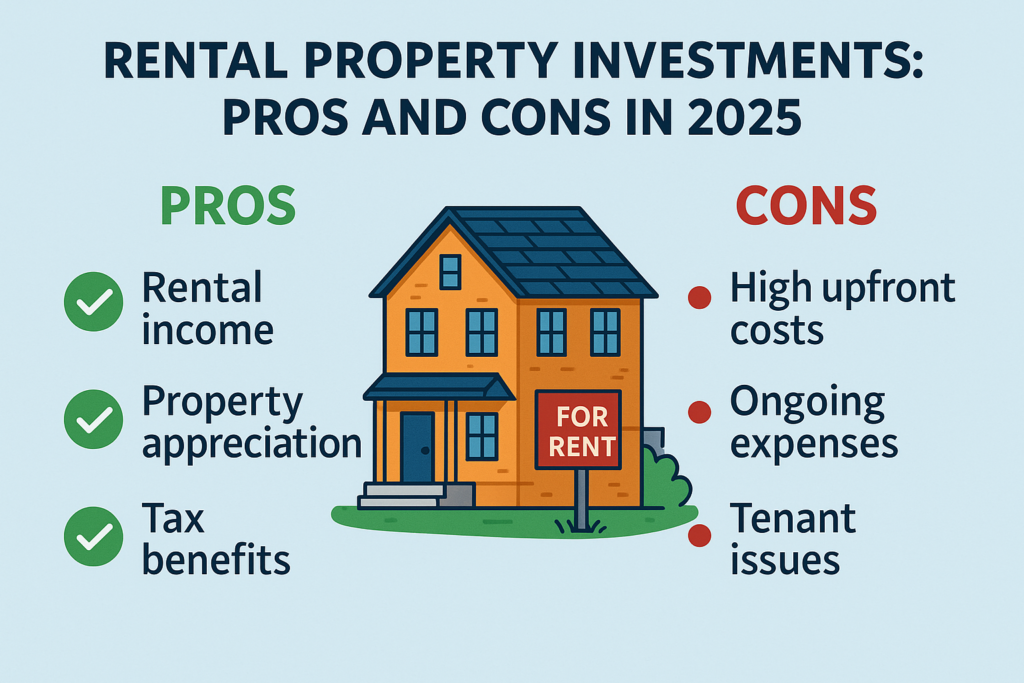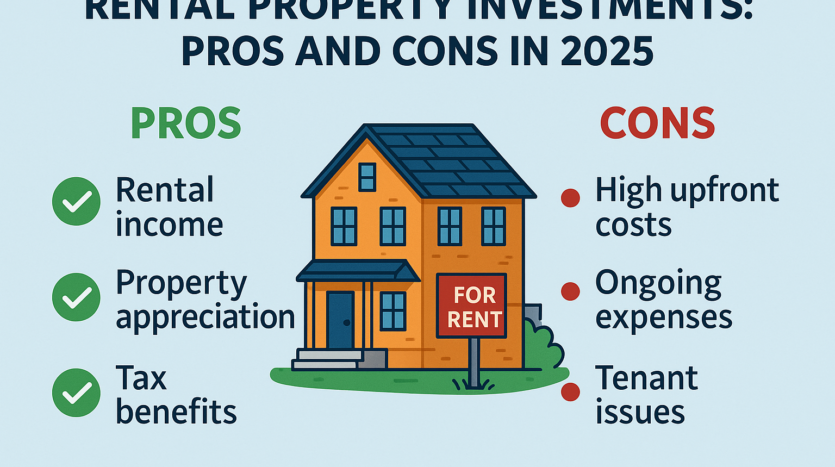Rental Property Investments: Pros and Cons in 2025
The landscape of rental property investment continues to evolve rapidly in 2025, shaped by economic shifts, technological innovations, and changing demographic preferences. For investors considering entering or expanding in this market, understanding the current advantages and challenges is essential for making informed decisions. This analysis explores the latest pros and cons of rental property investments based on current market conditions.

The Advantages of Rental Property Investments
1. Inflation-Protected Income Stream
In today’s economic environment, rental properties continue to serve as an effective hedge against inflation. With the Consumer Price Index showing sustained pressure on prices:
- Rental income typically adjusts upward with inflation, often outpacing it in high-demand markets
- Most expenses (like mortgage payments) remain fixed while rental income increases
- Recent data shows average rent growth of 4.2% nationally, compared to general inflation of 3.1%
This inflation protection becomes particularly valuable during periods of economic uncertainty, creating a financial buffer that few other investment vehicles can match.
2. Property Technology Revolution
The “PropTech” boom has transformed property management, making rental investments more accessible and profitable:
- Smart home systems reduce utility costs by an average of 15-20%
- Automated tenant screening platforms reduce vacancy periods by up to 30%
- Digital payment systems improve on-time rent collection rates by 25%
- AI-powered maintenance prediction tools decrease emergency repair costs by identifying issues before they become critical
These technological advances have substantially reduced the traditional “headache factor” associated with property management while simultaneously improving cash flow metrics.
3. Favorable Tax Treatment
The tax advantages of rental property investment remain significant and have even expanded in some areas:
- Depreciation deductions continue to provide substantial tax shields
- Interest expense deductions offset income (though with certain limitations)
- 1031 exchanges remain viable strategies for deferring capital gains
- New energy efficiency incentives provide additional tax credits for property improvements
- Opportunity Zone benefits continue through 2025 for qualifying investments
When properly structured, these tax benefits can dramatically improve after-tax returns compared to other investment classes with similar risk profiles.
4. Growing Renter Population
Demographic trends continue to favor rental property owners:
- Millennials and Gen Z show stronger preferences for renting than previous generations
- Remote work has created new rental demand in previously overlooked markets
- Housing affordability issues have extended typical renting periods for many Americans
- The 55+ renter demographic is expanding at nearly twice the rate of other segments
These trends have created a robust tenant pool that spans multiple generations and income levels, reducing vacancy risk across diverse markets.
5. Portfolio Diversification
Real estate continues to provide valuable diversification benefits:
- Rental properties maintain low correlation with stock market performance
- Physical assets provide protection against digital economic disruptions
- Local market focus can insulate investors from national economic downturns
- Multiple revenue streams (appreciation + cash flow) create balanced return profiles
This diversification value has proven particularly important during recent periods of market volatility.
The Challenges of Rental Property Investments
1. Increasing Regulatory Complexity
The regulatory environment for landlords has grown significantly more complicated:
- Rent control measures have expanded to 17% of major metropolitan areas
- Tenant protection regulations have strengthened across most states
- Environmental compliance requirements add new costs and reporting burdens
- Licensing and inspection requirements have become more stringent in many localities
These regulatory hurdles require more sophisticated management approaches and can substantially impact returns in certain markets.
2. Rising Interest Rate Environment
After years of historically low rates, the financing landscape has shifted:
- Mortgage rates averaging 6.2-6.8% have increased carrying costs
- Higher rates have compressed cap rates in many markets
- The spread between mortgage rates and cap rates has narrowed to historically low levels
- Refinancing opportunities have diminished compared to previous years
These financing challenges require more careful analysis of cash flow projections and have made leverage less advantageous than during the ultra-low rate environment.
3. Property Management Complexities
Despite technological improvements, property management challenges persist:
- Labor shortages have increased maintenance costs by an average of 12% year-over-year
- Supply chain disruptions continue to impact repair timelines and expenses
- Tenant expectations have risen regarding amenities and response times
- Legal complexities around evictions remain heightened in many jurisdictions
These factors combine to create ongoing operational challenges that can erode returns if not properly managed.
4. Market Volatility and Geographic Disparities
Real estate markets show increasing divergence between high-performing and struggling areas:
- Some previously hot markets have experienced rental rate plateaus or declines
- Climate change considerations have impacted insurance costs and availability in vulnerable regions
- Employment shifts have created unexpected demand changes in formerly stable markets
- Urban/suburban preference shifts continue to reshape demand patterns
This market fragmentation requires more sophisticated analysis and makes national trends less reliable as investment guides.
5. Liquidity Limitations
The fundamental liquidity constraints of real estate investments remain significant:
- Average time to sell investment properties has increased to 65-75 days in most markets
- Transaction costs continue to consume 6-8% of property value
- Market timing is increasingly difficult in rapidly changing conditions
- Forced sales during downturns can still result in substantial losses
These liquidity challenges necessitate longer investment horizons and adequate cash reserves.
Strategic Implications for Today’s Investors
The current landscape suggests several strategic approaches for rental property investors:
- Market Selection Precision: The growing disparity between markets makes location selection more critical than ever. Focus on areas with strong job growth, population increases, and limited new construction.
- Operational Efficiency: Implementing technological solutions for property management has moved from competitive advantage to necessity. Investors without digital systems face significant disadvantages.
- Regulatory Navigation: Building expertise in local regulations or partnering with knowledgeable property managers has become essential to protect returns.
- Financing Creativity: With traditional financing less attractive, alternative approaches like seller financing, private lending, and partnership structures offer valuable alternatives.
- Sustainability Focus: Properties with energy-efficient features not only capture tax benefits but also command premium rents and attract higher-quality tenants.
Conclusion
Rental property investment in 2025 presents a complex mix of opportunities and challenges. The fundamental advantages of inflation protection, tax benefits, and tangible asset ownership remain compelling, while technological innovations have improved operational efficiencies. However, investors must navigate a more complex regulatory environment, adjust to higher financing costs, and develop strategies for increasingly divergent local markets.
Those who approach rental property investment with proper research, realistic expectations, and appropriate risk management strategies can still achieve attractive risk-adjusted returns. The key lies in treating rental properties not as passive investments but as businesses requiring informed management and strategic adaptation to changing market conditions.
For more information like this Click here


